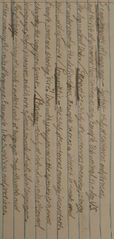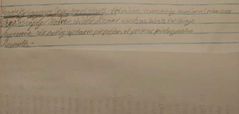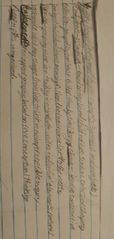![]()
![]()
![]()
Use LEFT and RIGHT arrow keys to navigate between flashcards;
Use UP and DOWN arrow keys to flip the card;
H to show hint;
A reads text to speech;
26 Cards in this Set
- Front
- Back
- 3rd side (hint)
|
Object permanence |
Understanding an object continues to exist even when it can not be seen. |
Example: if you place a toy under a blanket the child knows it is there and can actively see it. Like peek a boo game. |
|
|
Egocentrism |
Tendency for pre operational thinkers to view the world through their own experiences. |
Example: Little Suzy gets a phone call from mom who asks little Suzy if dad is home. Or seeing mom crying and young child gives his or hers favorite stuffed animal to make mom feel better. |
|
|
Zpd |
Children can do some things independently some things they can't do at all and others need assistance. |
Reading a book to child and child reads along with parent sounding new words. |
|
|
Scaffolding |
What we do to provide the help and unassisted level and model-label out loud. |
Example: ain't and reminders or learning to ride a bike. |
|
|
Assimilation |
Process by which we place new info into existing schema. |
When a child learns the world for dog, they start to call all four-legged animals dogs. |
|
|
Accommodations |
Process by which we create a new schema or drastically alter an existing schema to include new info and experiences that otherwise would not fit into schema. |
The schema for dog then gets modified to restrict it to only certain four legged animals. |
|
|
Schema |
Action or mental representation organized knowledge or how you understand something. |
Example: for a friend might include info about her appearance or behavior or personality or preferences. |
|
|
Piaget theory |
States children actively construct their understanding of the world and go through four stages of congnitive development. |
Example: sensorimotor ,preoperational, concrete operational, formal operational. |
|
|
Sensorimotor |
Age from 0-2 years old infants acquire info about the world through their senses and motor skills. |
Example: when a child sucks their thumbs. |
|
|
Preoperational |
Age 2-4/5 years old. Children think symbolically about object but they reason based on intuition and superficial appearance rather than logic. |
Example: representing things with words and images. |
|
|
Concrete operational |
Age 5/6- 11/12 years old. Children begin to think about and understanding logical operation and they are no longer fooled by appearance. |
Example: a child might be able to recognize her dog is Pomeranian and the Pomeranian is a dog. |
|
|
Formal operational |
Ages 12 years old and older. People can think abstractly and they can formulate and test hypothesis through deducted logic. |
Example: understanding concept of algebra, history or honesty. |
|
|
Sensorimotor 6 substages |
Reflex age 0-1 year old, primary circular reaction age 1-4 year old does with repeated reaction with body parts. Secondary age 4-8year old does with repeated reaction with objects. Coordination ages 8-12 years old purpose of doing something. Tertiary age 12-18 year old experimenting. Symbolic thought age 18-24 year old thinking it in their head without physically doing it. |
|
|
|
Critical period |
When an organism exposure to certain stimuli or experience produces proper development. |
Example: when child or duck becomes imprinted on any moving object in their immediate environment. |
|
|
Personal fable |
Belief the adolescent hold that unique thoughts and experience are special and invincible. |
Example: where the untrue bot taking how now one has ever done what you have done and taking the untrue and thinking how can that happen. Such as unprotected sex, drugs or dangerous acts. |
|
|
Imaginary audience |
Type of thought common in adolescent in which they believe others are just as concerned about their thoughts problem and characteristics as they are. |
Example: when child talks to their toys in a room with a person and when person moves to the next room the child picks up their toys and follows person in the next room. |
|
|
Attunement |
A sense the process of a parent feeling the child's feeling absorb those feeling and reflecting them back to the baby so baby knows he has been seen heard or understood. |
|
|
|
Perceptional map |
Child brain development understanding and response or connection on every language of sound has a sound. |
|
|
|
L.a.d. |
Develop helps acquire to get language. Evented by Chomsky. |
Example: when a young child starts to process the sound for language acquirment. |
|
|
Motherses |
Refers to baby talk to spontaneous way in which mother's and father's and caregiver speaks to infants and young children. |
Example: simple sentences structure repetition and limited vocabulary. Or when one surprise child into excitement and then child cry's and parents react in a response. |
|
|
5 components of language |

|
|
|
|
Vygotsky language development stages |

|
|
|
|
Vygotsky thought development stages |

|
|
|
|
Artificial concept |
Is man made not natural like cellphones and geometric shapes, like squares and triangles, every member shares a quality of characteristic trait |
|
|
|
Natural concept |
"bird" is based on your experiences with birds, which creates a mental prototype. Or in nature like trees. Every member has some of the characteristic trait but not all of them involves in nature. |
|
|
|
Hockett's criteria |
Used for there to be 13 design features.
|
Example: Vocal-auditory channel. Refers to the idea that speaking/hearing is the mode humans use for language. Broadcast transmission and directional reception When humans speak, sounds are transmitted in all directions. Total feedback Speakers of a language can hear their own speech and can control and modify what they are saying as they say it. Similarly, signers see, feel, and control their signing. |

